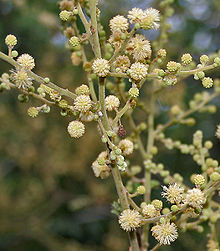Acacia leucophloea
| Vachellia leucophloea | |
|---|---|
 |
|
| Flowering in Vanasthalipuram, Hyderabad | |
| Scientific classification | |
| Kingdom: | Plantae |
| (unranked): | Angiosperms |
| (unranked): | Eudicots |
| (unranked): | Rosids |
| Order: | Fabales |
| Family: | Fabaceae |
| Genus: | Vachellia |
| Species: | V. leucophloea |
| Binomial name | |
|
Vachellia leucophloea (Roxb.) Maslin, Seigler & Ebinger |
|
| varieties | |
|
|
| Synonyms | |
|
|
Vachellia leucophloea (Hindi: रेवंजा), also called reonja, is a moderate sized tree found in southern India. It is sometimes mistaken for Prosopis cineraria with spreading crown and somewhat malformed and crooked trunk. It attains a height of about 20 to 30 ft and a girth of 2 to 3 ft. New leaves appear in April, and yellowish white flowers appear from August to October. The pods ripe by April and the seeds germinate readily if moisture is available. The tree is very hardy and stands drought well. It is frost hardy except in young age. It coppices well and produces good root suckers. It suffers from goat browsing particularly in early stage. Fruits are thin, flat, curved tomentose pods (difference from Prosopis cineraria).
The bark extracts of Vachellia leucophloea are used in Pakistan traditional medicine as an astringent, a bitter, a thermogenic, a styptic, a preventive of infections, an anthelmintic, a vulnery, a demulcent, an expectorant, an antipyretic, an antidote for snake bites and in the treatment of bronchitis, cough, vomiting, wounds, ulcers, diarrhea, dysentery, internal and external hemorrhages, dental caries, stomatitis, and intermittent fevers and skin diseases An ethanolic extract ointment has shown marked wound healing activity in trials.
The bark is used to prepare a spirit from sugar and palm-juice, and in times of scarcity it is ground and mixed with flour. The pods are used as a vegetable, and the seeds can be ground and mixed with flour.
...
Wikipedia
